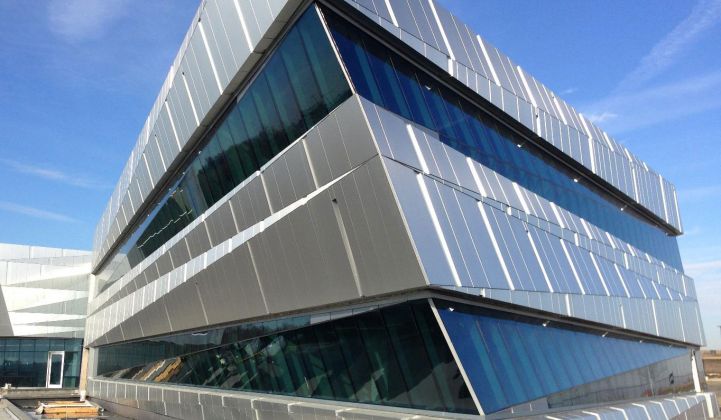View, the California-based tintable-window startup, just grabbed one of the biggest VC rounds we've ever covered — $1.1 billion from SoftBank Vision Fund at an undisclosed valuation.
Masayoshi Son's $100 billion SoftBank Vision Fund (which includes $45 billion from the rulers of Saudi Arabia) has made even bigger investments in Uber (more than $7.7 billion) and WeWork ($4.4 billion).
View has now raised close to $2 billion since its inception as Soladigm 11 years ago from investors including Corning, Madrone Capital Partners, Khosla Ventures, GE, TIAA Investments, Reinet Investments, NanoDimension, DBL Investors, Navitas Capital, Sigma Partners and The Westly Group.
It's not a pure-play cleantech investment, as View acknowledges when declaring the value proposition of its internet-addressable windows: Foremost is boosting employee health and productivity, followed by increasing property value, and lastly, saving energy by reducing lighting and HVAC electricity use by up to 20 percent. Regardless of priority, those are significant energy savings for a commercial building, if the claim is true.
Tinting windows with electricity
View says its Mississippi-built "dynamic" glass is installed in 35 million square feet of buildings in hundreds of installations in North America. After years in development and trials, the company is increasing capacity, growing revenue and amassing a backlog of projects. Flagship installations include a $25.5 million contract at Dallas-Fort Worth International Airport and projects at Facebook and FedEx.
Electrochromic glass uses a thin film of metal oxides that change the opacity of a window depending on voltage applied. Thermochromics and photochromics perform the same task by reacting to heat and light, respectively, rather than electricity.
View’s electrochromic technology originated out of Lawrence Berkeley National Lab; it sandwiches a deposited layer of tungsten oxide between two panes of glass. Startup Kinestral Technologies has a tintable glass technology and has raised more than $70 million from Asahi Glass, Hermes-Epitek, 5AM Ventures, Capricorn, Mitsubishi and Versant Ventures. Heliotrope, another startup, uses indium tin oxide electrochromics to filter out light and heat.
View’s major competitor, SageGlass, was acquired by Saint-Gobain in 2012 and counts universities, government buildings and healthcare facilities as clients for its electrochromic glass.
Big niche or mainstream market?
The $1.1 billion investment from SoftBank Vision Fund is intended to scale View's manufacturing capacity in Mississippi and continue development of longer-term applications in security and displays. The View factory appears to be one of former Mississippi Governor Haley Barbour's cleantech industrial success stories — as opposed to biofuel failure Kior or defunct solar panel builder Stion.
Electrochromic windows can cost two to four times as much as a standard double-paned window, although the costs of shades and blinds are eliminated. There are wiring and power costs associated with dynamic windows, as well as the UL and code issues brought by introducing a new technology to the historically conservative building industry.
Some of Silicon Valley's past forays into building markets have exposed the region's arrogance and myopia; the long-gone Serious Materials comes to mind. But, View seems to have made it through many of the obstacles of early startup death. A decade in, the company is growing sales, scaling its manufacturing and there's money in the bank.
Research and Markets pegs the global smart glass market as $3.12 billion in 2017 with a forecast of $14.24 billion by 2026, while the global market for construction glass is forecast as $115 billion by 2020. Even if smart glass remains the domain of prestige buildings and showcase construction, it's still a big niche.
As a venture-funded company, strong growth is not enough for View — there is the expectation of an exit by way of acquisition or IPO. And given the money already invested, that will have to be a sizable transaction to be scored a success. Is the market ready for a smart window company with a multibillion-dollar IPO? Or is there an infrastructure major that wants to make a multibillion-dollar acquisition?
We know how the private investors feel. The question is whether the public markets will value View as an advanced technology startup or as a building materials company.




